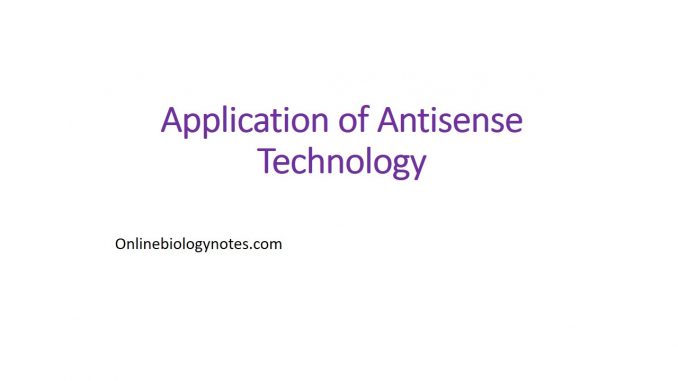
- Antisense technology is used successfully in two general areas, especially viral infections and cancers. However, different newer field have been emerging as the antisense technology advances.
Antisense in viral infection:
- It has always been difficult to design and develop antiviral drugs with low toxicity and improved specificity. A rational strategy to fight against viral diseases is to inhibit the genes implicated in various viral infections with the help of Antisense oligonucleotides.
- Antisense technology can be easily applied to viruses as they encode unique proteins, very different from the ones encoded by normal cells.
- Antisense oligonucleotides are selective and highly specific and binds with targeted viral mRNA and down regulate the expression of viral proteins, thus inhibit the virus replication. Thus this antisense technology can be used to design therapeutic compounds targeted to specific mRNA to treat various viral diseases.
- Vitravene (fomivirsen) is the first antiviral Antisense drugs used to treat cytomegalovirus retinitis. Other potential targets of antisense drugs include human papillomavirus, HIV, hepatitis-B virus, influenza A virus, and herpes simplex virus (HSV)
Antisense in cancer:
- As antisense drugs are less toxic than conventional drugs, many antisense oligonucleotides are currently investigated to treat various cancers in humans or for the deactivation of oncogenes.
- For the first time an antisense oligonucleotide in combination with cisplatin was approved to treat bladder cancer.
Antisense in genetic research:
- The most widely used application of this technology is in gene therapy.
- Antisense oligonucleotides are being used in genetic research to treat various genetic disorders.
- In genetic disorders, some point mutations resulting in the formation of a defective mRNA and then defective protein.
- Antisense oligonucleotides blocks the formation of defective mRNA and then defective proteins.
- The therapeutic objective of antisense technology is to block formation of defective protein from defective mRNA. When a synthetic “antisense” or complementary nucleotide sequence interacts with defective mRNA. This “mRNA”- antisense complex” can no longer be translated and the disease causing protein cannot be produced.
- β-thalessemia; n genetic blood disorder can be completely treated using antisense technology in which O-alkyl oligonucleotides or morpholino-oligonucleotides have been used.
Medical applications of antisense
- Antisense technology is used to investigate protein function in the living brain to study central nervous system (CNS) proteins such as transmembrane receptors, ion channels, transporters, G proteins, and growth factors.
- Antisense oligonucleotides can be used to inhibit expression of a particular enzyme. For eg. Inhibition of acetyl cholinesterase enzyme is the molecular target for the treatment of diseases like Alzheimer’s disease.
- In inflammatory diseases, antisense oligonucleotides is used to demonstrate the relative importance of various signaling components at the molecular level.
- A novel respirable antisense drug called RASONS is used to treat various respiratory diseases including asthma, influenza, bronchitis, pulmonary fibrosis, pneumonia, and lung cancer
- Antisense oligonucleotide can be used target specific membrane component that influences the pathophysiological mechanisms in renal and cardiovascular disorders.
